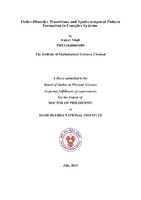- DSpace Home
- →
- IMSc Theses/ Dissertations
- →
- IMSc Theses/ Dissertations
- →
- View Item
JavaScript is disabled for your browser. Some features of this site may not work without it.
| dc.contributor.author | Rajeev Singh | |
| dc.date.accessioned | 2014-10-31T06:38:05Z | |
| dc.date.available | 2014-10-31T06:38:05Z | |
| dc.date.issued | 2014 | |
| dc.date.submitted | 2013 | |
| dc.identifier.uri | https://dspace.imsc.res.in/xmlui/handle/123456789/359 | |
| dc.description.abstract | In this thesis, the author investigates how patterns can arise by considering several models of complex systems comprising large number of components interacting with each other via non-trivial connection topologies. Such complexity is ubiquitous in the natural world (especially in living systems) and their spatio-temporal dynamics can often have functionally critical consequences for biological organisms. This study is aimed at contributing towards building a general theory for describing pattern formation and ordering in “complex” systems. The models considered are capable of exhibiting a variety of novel complex patterns and collective order, some of which may in fact have manifestations in real systems, such as the mammalian uterus. Systematic investigations of the mechanisms are presented resulting in the generation of such patterns, - a challenging exercise due to the large number of interacting components involved and the complicated nature of the coupling. The emergence of various dynamical regimes have been characterized in terms of distinct non-equilibrium steady state properties for systems that span a range of different types of components and their interactions. At the level of component dynamics, the temporal behavior ranges from threshold-activated dynamics with either discrete-state transitions or continuous-state behavior to those which display relaxation oscillations or even passive response. On the other hand, the nature of the interactions in the systems investigated in this study range from exchange interactions to diffusive coupling to effective synapse-like connections. | en_US |
| dc.publisher.publisher | The Institute of Mathematical Sciences | |
| dc.subject | Complex Systems | en_US |
| dc.subject | HBNI Th74 | en_US |
| dc.subject | Pattern Formation | en_US |
| dc.subject | Spatio temporal Pattern | en_US |
| dc.title | Order-Disorder transitions and spatio-temporal pattern formation in complex systems [HBNI Th74] | en_US |
| dc.type.degree | Ph.D | en_US |
| dc.type.institution | HBNI | en_US |
| dc.description.advisor | Sitabhra Sinha | |
| dc.description.pages | 114p. | en_US |
| dc.type.mainsub | Physics | en_US |
| dc.type.hbnibos | Physical Sciences |
Files in this item
This item appears in the following Collection(s)
-
IMSc Theses/ Dissertations
IMSc Theses/ Dissertations
